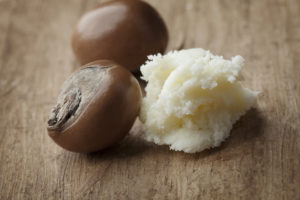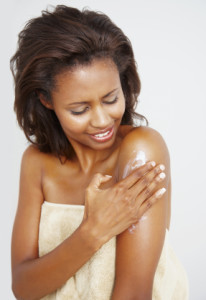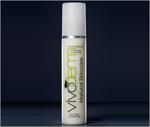The Healing Power of Shea Butter
We all know that hydration is crucial and that drinking plenty of water optimizes the functions of the body. What some people forget is that the body needs not only to be hydrated from the inside but also from the outside. With the summer sun sapping moisture from your skin, it’s the perfect time to introduce ultra-moisturizing shea butter treatments into your skincare regimen.
Shea butter comes from nuts of karite trees, which are only found in the wild in the savannah regions of West and Central Africa. It is said Cleopatra used to smooth shea butter onto her body to counteract Egypt’s scorching climate. Centuries later, people around the world turn to this versatile skincare ingredient for all manner of applications from soothing scrapes to treating parched hair.

closeup of shea butter and shea nuts
Shea trees can live for 300 years, but they produce nuts only once annually. It takes about 15 to 30 years for karite trees to bear high-quality fruit that is later crushed and boiled to obtain a yellowish-colored fatty extract. According to the American Shea Butter Institute (ASBI), this product, which is rich in vitamins A, E, and F, is a superior moisturizer that contains remarkable healing properties for a variety of skin ailments, including eczema, psoriasis, and acne. It is also used to fortify and protect cell membranes, fade scars, minimize the appearance of stretch marks and wrinkles, improve hyperpigmentation, offer natural protection from harmful ultraviolet rays, and even relieve sinus problems. Shea butter is known as one of the most effective skin healers and moisturizers ever created. Originally used by African healers thousands of years ago, shea butter remains one of nature’s most potent skin rejuvenators and hydrators.
The ASBI recommends using the cold pressed shea butter that does not contain chemicals or preservatives. The ASBI classifies products as A, B, C or F. Class A is premium shea butter while class F is poor quality shea moisturizer. Pure shea butter is also edible and has long been used for cooking in many parts of Africa. Unrefined 100 percent shea butter is available at health food stores throughout the US.
This deeply nourishing product also has a low melting point, and it penetrates quickly when it comes in contact with the skin without leaving behind any greasy residue. Shea butter’s ease of use and myriad benefits have made it extremely popular and a darling on spa menus. Shea butter is high in oleic acid – a deeply moisturizing essential fatty acid that comprises the trademark thick texture. It’s also an ideal carrier for essential oil blends and mixes well with other oils such as fractionated coconut, jojoba and safflower.

While shea butter is effective on the body, it can also help people put their best faces forward and be a saving grace for those with troubled skin. Studies have shown it to be a natural anti-inflammatory agent. It decreases any acne flare-ups while naturally hydrating the skin, hence normalizing the sebum production to avoid future outbreaks – leaving the skin less oily.
Shea butter works well on all skin types, even sensitive skin. In addition, it boasts cinnamates and other compounds that may help inhibit enzymes that contribute to the inflammatory response.
The delicate and wrinkled eye area can benefit greatly from using shea butter to plump the skin around the eye area and help erase crow’s feet. Because the eye area does not have many oil glands, the skin around the eyes easily dehydrates without the ability to reproduce oil. The use of shea butter in eye cream provides a rich and healing source of hydration to penetrate the neglected eye area, keeping it supple and helping it retain moisture.
Also look for shea butter in your all over body creams and body butters. Shea butter and Coca Butter is used to help skin of all types heal and regain moisture levels and leave a silky finish. In addition to treating the delicate eye area, lips and lip lines can also be improved with shea butter. Not only does shea butter nourish the skin but it is also used to treat troubled tresses. Warm shea butter can be applied to the shaft of the hair to heal, protect, and penetrate every strand to make hair shinier, softer, and stronger. This treatment is perfect for people with dry, damaged, or over-processed hair as it promotes restructuring of the hair shaft. It’s beneficial to those who have been exposed to the sun and ocean, or extreme elements that are damaging and drying to the hair.
No matter what your outdoor preference is this summer –whether it is swimming, hiking or simply sunning – be sure to include versatile shea butter in your skin care treatment plans!





